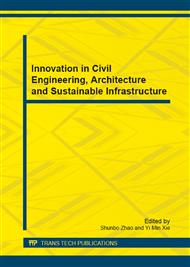[1]
Z. Zhou, J. Ou, Study on smart FBG sensors and their applications in civil engineering, Chinese High Technology Letters, 4 (2005) 23-28.
Google Scholar
[2]
Z. Lu, Application of high performance FRP and innovations of structure engineering, Journal of Architecture and Civil Engineering, 1 (2005) 1-5.
Google Scholar
[3]
L.C. Hollaway, A review of the present and future utilization of FRP composites in the civil infrastructure with reference to their important in-service properties, Construction and Building Materials, 24 (2010) 2419-2445.
DOI: 10.1016/j.conbuildmat.2010.04.062
Google Scholar
[4]
F. Peng, L. Ye, FRP structures and FRP composite structures in structural engineering, China Civil Engineering Journal, 3 (2006) 14-18.
Google Scholar
[5]
Q. Yue, Y. Yang, High performance fiber reinforced composite and modern civil engineering application, in: The 15th National Composite Materials Academic Conference, 2008, 31-36.
Google Scholar
[6]
Camille A. Issa, Antoine Nasr, An experimental study of welded splices of reinforcing bars, Building and Environment, 41 (2006) 1394-1405.
DOI: 10.1016/j.buildenv.2005.05.025
Google Scholar
[7]
J. Zhou, Q. Du, J. Lu, S. Chen, Experimental study of glassfiber reinforced polymer bar joint, Fiber Reinforced Plastics/Composites, 5 (2005) 24-27.
Google Scholar
[8]
B. Tighiouart, B. Benmokrane U, Phalguni Mukhopadhyaya, Bond strength of glass FRP rebar splices in beams under static loading, Construction and Building Materials, 13 (1999) 383-392.
DOI: 10.1016/s0950-0618(99)00037-9
Google Scholar
[9]
J. M. Lees, B. Gruffydd-Jones, C. J. Burgoyne, Expansive cement couplers-A means of pre-tensioning fiber-reinforced plastic tendons, Construction and Building Materials, 6 (1995) 413-423.
DOI: 10.1016/0950-0618(95)00070-4
Google Scholar
[10]
T. Harada, T. Idemitsu, A. Watanabe, M. Khin, K. Soeda, New FRP tendon anchorage system using highly expansive material for anchoring. In: Modern Prestressing Techniques and Their Applications, Proceedings Volume II, FIP93 Symposium, Japan, 1993: 71 l-718.
DOI: 10.2208/jscej.1999.627_77
Google Scholar
[11]
V. Navaratnarajah, Splicing of reinforcement bars with epoxy joints, International Journal of Adhesion and Adhesives, 2 (1983) 93-99.
DOI: 10.1016/0143-7496(83)90023-4
Google Scholar
[12]
Jacob W. Schmidt, Anders Bennitz, Bjőrn Täljsten, Per Goltermann, Henning Pedersen, Mechanical anchorage of FRP tendons-A literature review, Construction Building Materials (2012), doi: 10. 1016/j. conbuildmat. 2011. 11. 049.
DOI: 10.1016/j.conbuildmat.2011.11.049
Google Scholar
[13]
Colin MacDougall, Mark Green, Lucio Amato, CFRP tendons for the repair of post-tensioned, unbonded concrete buildings, Journal of Performance of Constructed Facilities, 3 (2011) 149-157.
DOI: 10.1061/(asce)cf.1943-5509.0000146
Google Scholar
[14]
J. Zhang, H. Zhu, Z. Lu, K. Zhao, Development of anchor devices of prestressed FRP tendon, Industrial Construction, add (2004) 259-262.
Google Scholar
[15]
G. Yuan, G. Dong, J. Ma, Study of coaxial FRP sleeve/expansion Cement connection of FRP rebers, 18th International Conference On Composite Materials, 2011, Jeju Island, Korea.
Google Scholar
[16]
G. Yuan, G. Dong, J. Ma, Luciano Feo, David Hui. Study of coaxial connecting methods of FRP rebars with winding fiber cloth composites. 19th Annual International Conference on Composites or Nano Engineering, July 23-28, Shanghai, China.
DOI: 10.1260/1708-5284.11.1.37
Google Scholar
[17]
W. Min, Finite Element Value Simulation of Composite Bolt Threaded Nut Contact and Experimental Study, Master Degree Thesis, Taiyuan University of Science and Technology, (2008).
Google Scholar
[18]
Y. Zhu. Connection of pultrusion GFRP rod, Fiber Reinforced Plastics, 2 (1981) 7-17.
Google Scholar
[19]
ACI 440. 1R-06, Guide for the Design and Construction of Structural Concrete Reinforced with FRP Bars, American Concrete Institute (ACI), (2006).
DOI: 10.1061/40753(171)158
Google Scholar
[20]
B. Benmokrane, Bond strength of FRP rebar splices, Proceedings of the Third International Symposium on Non-Metallic (FRP) Reinforcement for Concrete Structures (FRPRCS-3), Vol. 2, Japan Concrete Institute, Tokyo, Japan, 1997: 405-412.
DOI: 10.1007/bf02480431
Google Scholar
[21]
C. P. Mosley, Bond performance of fiber reinforced plastic (FRP) reinforcement in concrete, MS thesis, Purdue University, West Lafayette, Ind., (2002).
Google Scholar
[22]
GB50010-2010, Code for Design of Concrete Structures, China Building Industry Press, Beijing, (2011).
Google Scholar
[23]
C. Fu, Z. Zhou, B. Wang, Study of GFRP bar used in concrete, Fiber Reinforced Plastics/Composites, add. (2001) 254-257.
Google Scholar
[24]
G. Yuan, Research report about the performance testing and connection method of FRP bars, School of Aerospace Engineering and Applied Mechanics, Tongji University, (2009).
Google Scholar


